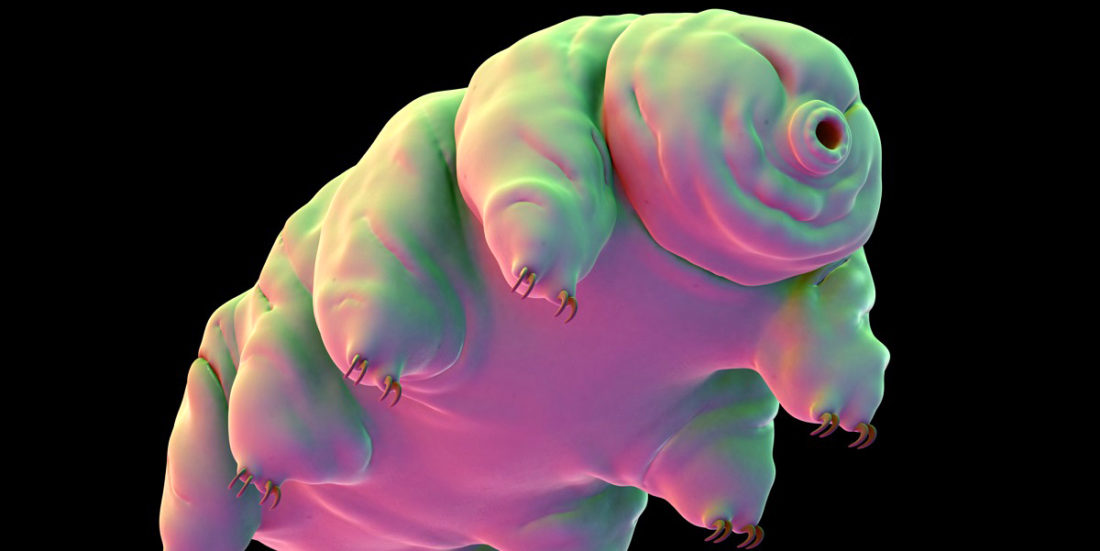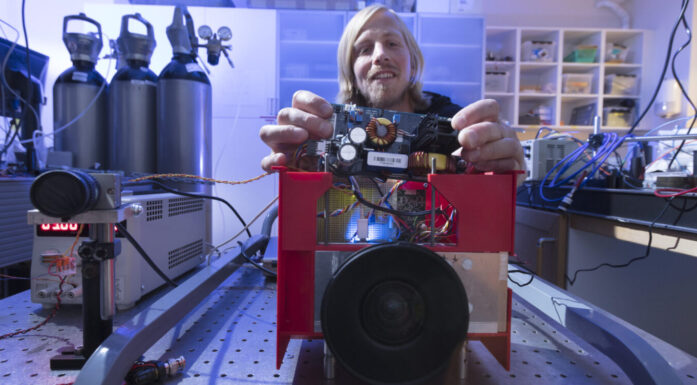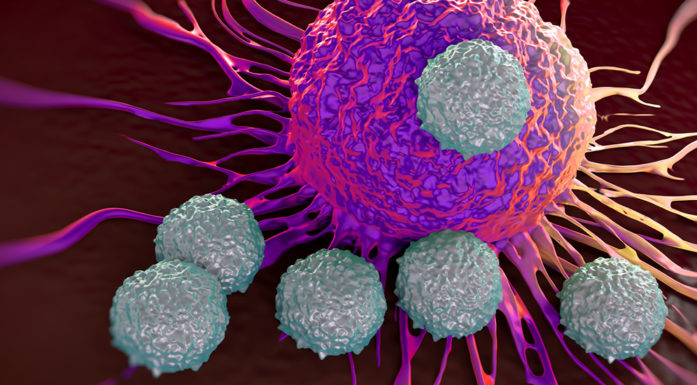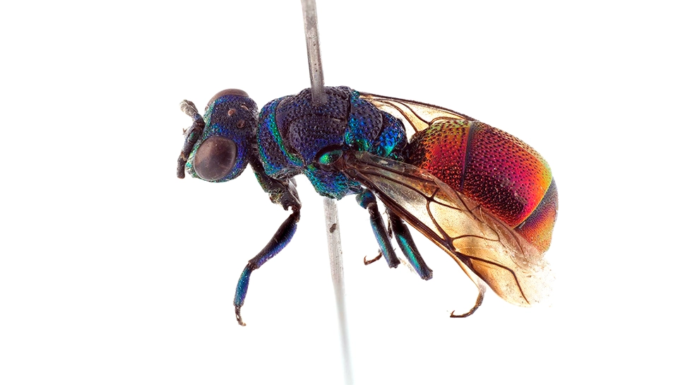Water bears survive in space and the ocean’s depths
These animals can survive outer space conditions. They can provide new insights into cancer and what ageing does to us. But you’ve probably never heard of them before.
TARDIGRADA: Some of the world’s leading researchers recently gathered at the NTNU University Museum in Trondheim to learn more about some of the most fascinating animals you can imagine.
They’re called water bears or moss piglets, and only a few people have ever seen them. That’s maybe not so strange, given that the largest specimens measure a mere 1.5 millimetres long. But despite their diminutive stature, they can provide valuable insight into some very exciting biological processes.
These critters are in fact tough little guys. Some water bears, or tardigrades, as they’re officially known, can survive freezing down to absolute zero, exposure to extreme drought or radiation doses far exceeding what other living organisms can cope with.
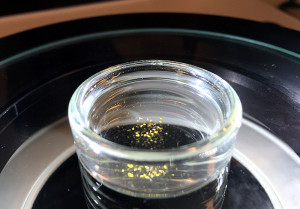
Water bears under the microscope: Richtersius coronifer from Öland has been awakened from a deep sleep. Photo Torbjørn Ekrem, NTNU University Museum
Their hardiness could enable them to tell us how cells can regenerate or repair themselves. This makes them particularly intriguing to both cancer researchers and scientists who are interested in how ageing affects our bodies.
- You might also like: Mapping life’s barcodes in Norway
Found everywhere
Professor K. Ingemar Jönsson at Kristianstad University in Sweden is one of the world’s foremost experts on tardigrades.
“Water bears can be found more or less everywhere,” says Professor Jönsson.
And in huge numbers. Close to 1,000 water bears can be found in one gram of dry moss.
The researchers who met in Trondheim took a random sample of moss on trees outside the University Museum. In this sample alone, they found at least three different tardigrade species.
Great variation
Tardigrades are a varied lot, with 1220 described species. Most live in mosses, lichens, soil and leaf litter, some in seabed sediments and on algae in the ocean and in freshwater. They show up from the deepest depths to the highest mountain peaks, and from Antarctica to the Arctic. Most of them are herbivorous, omnivorous, bacteriovorous or predators, the others are parasites.
Strange and wonderful water bears
- Tardigrades have been around on Earth for at least 90 million years. Findings of tardigrade-like fossils from Siberia suggest that its forebears were here already 500 million years ago.
- People have known about tardigrades since the German J. A. E. Goez discovered them in 1773. The Italian Lazzaro Spallanzani named them tardigrades 3 years later.
- The Norwegian Biodiversity Information Centre funded workshop at the NTNU University Museum.
- During the meeting researcher found nearly 20 species in the moss herbarium and in moss and lichen samples from downtown Trondheim.
- The species will be DNA barcoded in cooperation with the Norwegian network for DNA barcoding (NorBOL [www.norbol.org]).
Some species reproduce sexually, while for others asexual reproduction, in which eggs can develop without male involvement, is the norm. Some are even hermaphrodites, both male and female.
Although not fully understood, tardigrades can maintain their genetic variation by taking up large amounts of genetic material from other organisms such as bacteria, archaea, fungi and plants. Water bears incorporate this alien genetic material into their own, a process called horizontal gene transfer.
“According to a new study, up to 17.5 per cent of their DNA can come from other species,” says Jönsson, although that find was recently disproven.
- You might also like: Bringing new life to old bones
Water bears in space
To the extent that water bears are known for anything, it is probably that they can withstand extreme stresses. Perhaps more than anyone else, Professor Jönsson has helped to make tardigrades better known. In 2007, he headed up a European space project that sent 3000 water bears into space to be exposed to the extreme conditions there.
“Weightlessness, cosmic rays and UV radiation,” he sums up.
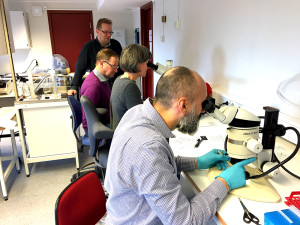
Identifying water bears during the Tardigrade workshop at the NTNU University Museum. From left: Karstein Hårsaker, Terje Meier, Elisabeth Stur og Roberto Guidetti. Photo Torbjørn Ekrem, NTNU University Museum
In the 1920s, a monk named Gilbert Franz Rahm experimented with freezing tardigrades to 272 degrees below zero and heating them up to 151 degrees—without those experiments taking a toll on them. Thus, as early as 1923, Rahm claimed that tardigrades could survive in space.
“Why not test it out?” asked Jönsson, who gained access to the European Space Agency ESA research programme along with colleagues in Cologne, Stuttgart and Stockholm.
The project was named “Tardigrades in space”, and even though fans of Doctor Who might be excited, the acronym TARDIS was simply a coincidence.
Four different species were part of the journey on the FOTON-M3 mission from Kazakhstan in September 2007. Two of them were exposed to UV radiation of up to 7000 KJ /m2 and cosmic radiation at 5-100 mGy. The trip took 12 days.
“Space had no effect on the animals’ survival, and 10-15 per cent of the species that were exposed to UV radiation survived long enough to produce offspring that were fit for survival,” says Jönsson.
For a while afterwards his phone rang off the hook. Unfortunately, a follow-up project in 2011 crashed, literally. The spacecraft Fobos-Grunt was slated to send living organisms, including water bears, to the Martian moon Phobos, but crashed during launch.
This trip was also going to look at the possibility of panspermia, and that life on our planet may have come from the outside through life forms surviving long stays in space. Bacteria can survive for long periods of time.
But now we won’t know for a while whether to count tardigrades among the species that can colonize new planets or moons. Further research beyond Earth has stalled due to lack of funding. It isn’t easy to gain access to the International Space Station.
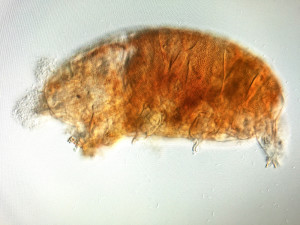
A water bear from the Pseudechiniscus family seen under a light microscope. Photo: Torbjørn Ekrem, NTNU University Museum
Tolerate dehydration
Tardigrades’ ability to survive in space is really due to their extreme ability for survival on land.
Water bears can hibernate if they don’t have enough access to water, and during this dormancy, their metabolism stops completely. The chemical processes that convert food, water and oxygen into energy actually shut down.
“Metabolically they die, but structurally they’re still alive,” says Jönsson. Water bears can come to life again when conditions around them return to normal.
“We know that they can survive for three decades in a frozen state. Two decades at room temperature when they are dry,” he adds.
There have been reports of tardigrades that have survived over 100 years before they were revived, but Jönsson is extremely sceptical of this information. In one case, for example, tardigrades were revived from kiln-dried moss after 120 years. That case reported one or a few individuals that barely moved before they died.
The animals are able to stabilize cell structure. Their ability to form trehalose has been suggested as one of the secrets behind their great survival. This substance prevents various parts of the cell from degrading by keeping them in a glass-like, but stable form, liquid but stable. But water bears have low levels of trehalose, and it is unclear whether this sugar matters to the animals’ survival ability.
Radioactivity
But tardigrades are very resistant to more than dehydration. The old joke goes that cockroaches will take over the Earth after a nuclear war. But maybe it will be tardigrades instead.
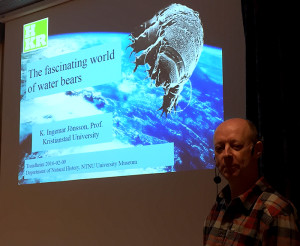
Professor K. Ingemar Jönsson gives a lecture about the fascinating world of the water bear. Photo: Torbjørn Ekrem, NTNU University Museum
Human beings cannot tolerate more than 5-6 Gray (Gy), which is an expression for absorbed radiation dose. Cockroaches can handle a couple hundred Gy, and are thus much hardier than we are. But tardigrades have survived up to 10,000 Gy, depending on the species and type of radiation.
“The animals are more sensitive in their early development stages, perhaps because of cell division,” says Jönsson.
It’s doubtful that resistance to radioactivity is a direct result of evolution. Jönsson says resistance “is probably an evolutionary by-product. They’re actually adapted to dehydration. Tolerance is a bonus.”
There is a lot still to learn about these critters. Water bears have effective mechanisms for repairing damaged DNA. The DNA molecules start to decompose at 10-40 Gy. But their DNA is already repaired a few days after the radiation. The same breakdown occurs in dry conditions.
“We don’t know how DNA is repaired,” said Jönsson. But it’s very interesting to research this further, to see how cells can renew themselves. Cancer and ageing researchers should be ready to learn more about these animals.
Italy at the forefront of research
Jönsson is about the only water bear researcher in Sweden. But Italy is a leader in the field.
Dr. Roberto Guidetti at the University of Modena and Reggio Emilia is part of a research group that is at the forefront of water bear research. He is a taxonomist who specializes in tardigrade structure and kinship.
During the meeting in Trondheim, he demonstrated how he prepares specimens for experiments.
Dr. Łukasz Kaczmarek, from Adam Mickiewicz University in Poznán, Poland, has studied tardigrades since he was a student and has extensive experience in the field.
“Here we’re learning from each other,” says Kaczmarek, who uses slightly different techniques than Guidetti does. The researchers do not meet very often, so workshops like this one are important.
Tardigrade specialists aren’t particularly abundant. Periodically they gather for conferences. All told, about 100 researchers met in Italy last year.
Norway’s contributions
Terje Meier is probably Norway’s leading expert on tardigrades. “I majored in tardigrades once upon a time,” he says.
The zoologist discovered, however, that there was a dearth of job opportunities for water bear experts, and he has spent most of his working life in the publishing industry instead. But in his spare time, he focuses on tardigrades, and he has been more or less everywhere in Norway to collect specimens.
Meier has his own laboratory at home in Oslo where he so far has identified around 150-160 species, of which he’s confirmed 136 of them. He is working to create an overview for all of Norway, and estimates that around 250 species exist in the country. But since he doesn’t have access to the most advanced technology to distinguish the different species, his work has slowed down somewhat.
Norwegian research group
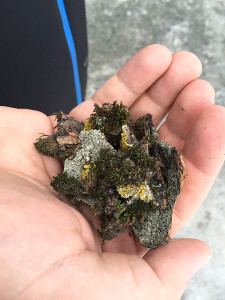
Moss and lichen from right outside of the NTNU University Museum. These samples contained three species of tardigrades. Photo: Torbjørn Ekrem, NTNU Univerisity Museum
NNow Meier has made his collection of 3000 prepared specimens available to the NTNU University Museum. Professor Torbjørn Ekrem of the Department of Natural History is pleased: “We want to create a research group for tardigrades,” he says.
Midges are Ekrem’s specialty, but he wants to know more about tardigrades. Meier’s collection is essential, and several of the species that he has identified are used as references for ongoing tardigrade identification. The results will now be digitized and geo-referenced, which means they will be linked to information about the discovery site.
The University Museum will also conduct DNA analysis and will DNA barcode the water bears, which can help to find even more species.
A model organism
Researchers, including Jönsson, now hope that one tardigrade species may become a biological model organism, especially because researchers have recently sequenced a water bear’s entire genome for the first time.
A model organism is a species that is thoroughly investigated to provide basic knowledge about biological processes that is also useful when other organisms are examined. Having this kind of information may encourage more researchers to take up studies of tardigrades. It could even boost funding.
And perhaps we could again send water bears into space.
